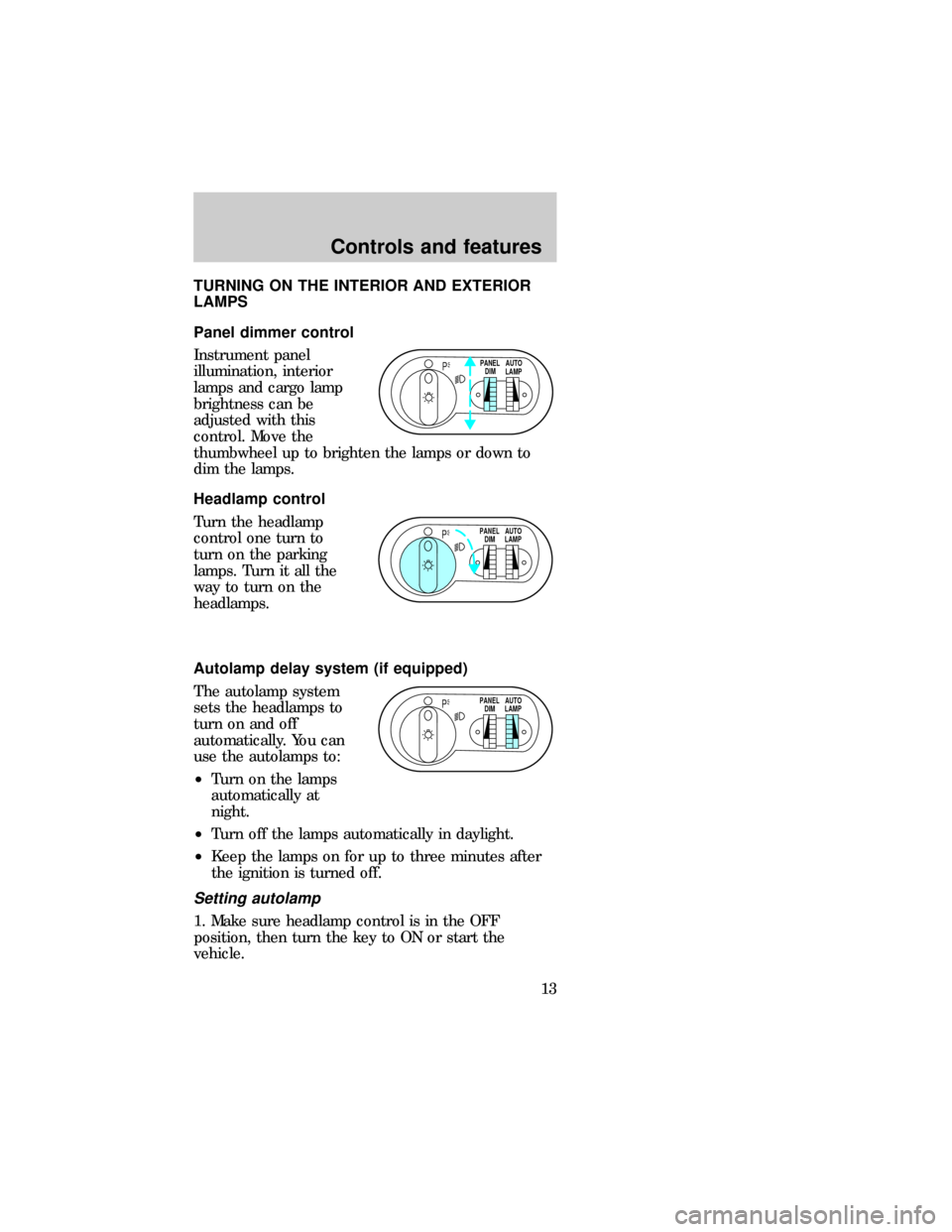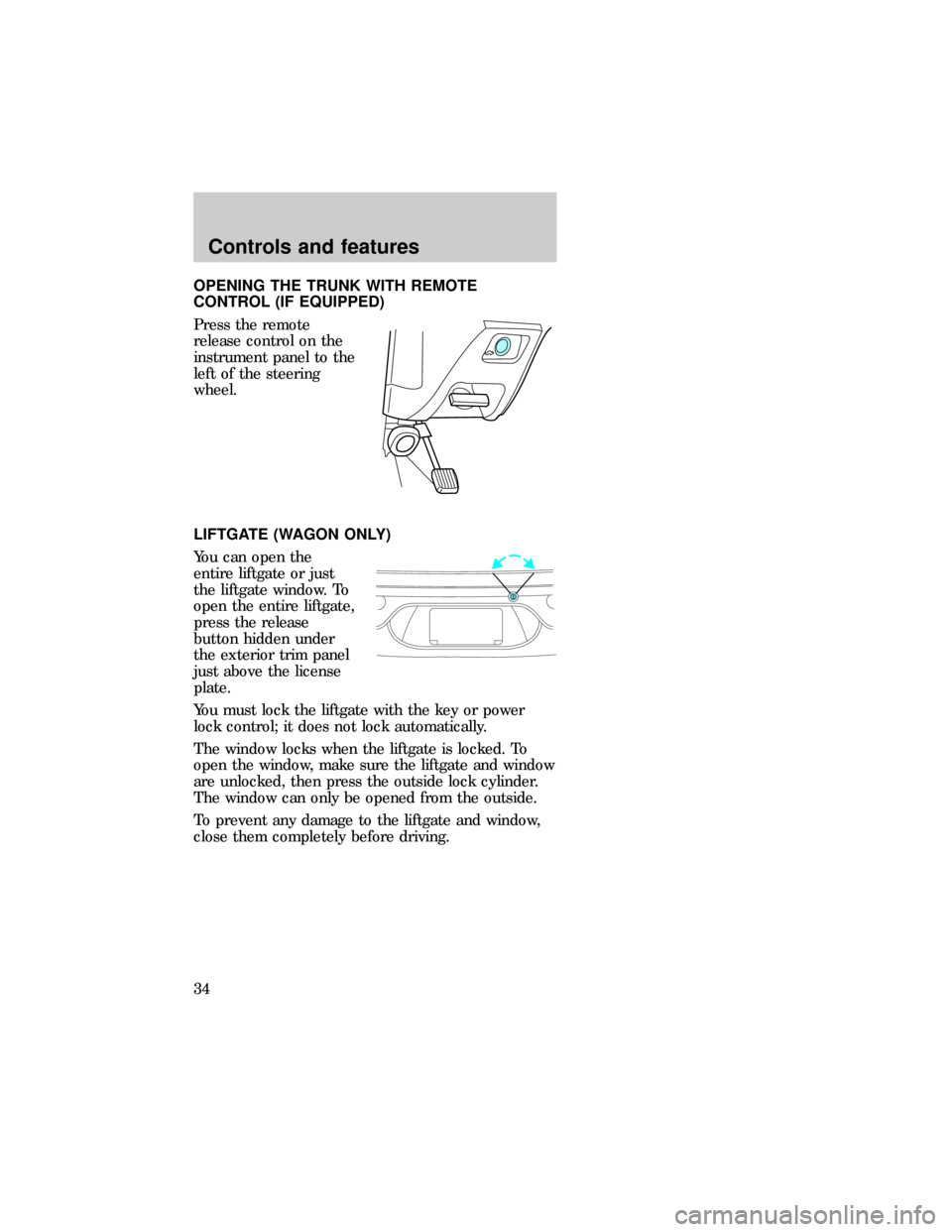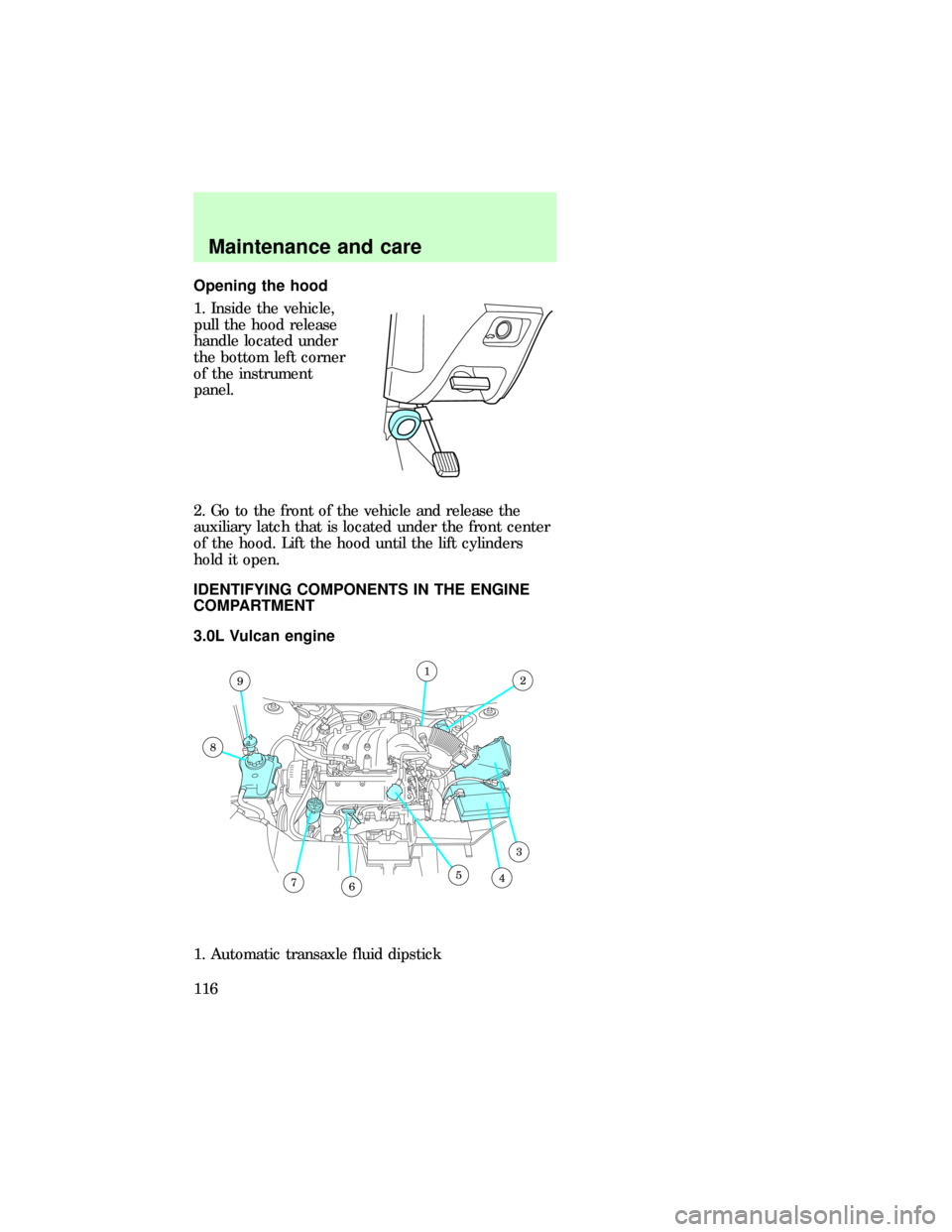instrument panel Mercury Sable 1997 Owner's Manuals
[x] Cancel search | Manufacturer: MERCURY, Model Year: 1997, Model line: Sable, Model: Mercury Sable 1997Pages: 167, PDF Size: 1.59 MB
Page 13 of 167

TURNING ON THE INTERIOR AND EXTERIOR
LAMPS
Panel dimmer control
Instrument panel
illumination, interior
lamps and cargo lamp
brightness can be
adjusted with this
control. Move the
thumbwheel up to brighten the lamps or down to
dim the lamps.
Headlamp control
Turn the headlamp
control one turn to
turn on the parking
lamps. Turn it all the
way to turn on the
headlamps.
Autolamp delay system (if equipped)
The autolamp system
sets the headlamps to
turn on and off
automatically. You can
use the autolamps to:
²Turn on the lamps
automatically at
night.
²Turn off the lamps automatically in daylight.
²Keep the lamps on for up to three minutes after
the ignition is turned off.
Setting autolamp
1. Make sure headlamp control is in the OFF
position, then turn the key to ON or start the
vehicle.
PPANEL
DIMAUTO
LAMP
PPANEL
DIMAUTO
LAMP
PPANEL
DIMAUTO
LAMP
dno_interior-exterior-lamps
dno_dimmer-switch
dno_headlamp-switch
dno_autolamps
Controls and features
13
Page 15 of 167

Mode selector control
Controls the direction
of the airflow to the
inside of the vehicle.
²MAX A/C - Uses recirculated air to cool the
vehicle. It allows for faster cooling but is noisier
than A/C. The air conditioning compressor will
operate in this mode.
²A/C - Uses outside air to cool the vehicle. It is
quieter than MAX A/C but not as economical. The
air conditioning compressor will operate in this
mode.
²VENT - Distributes outside air through the
instrument panel registers.
²OFF - Outside air is shut out and the fan will not
operate.
²
(Panel and floor) - Distributes outside air
through the instrument panel registers and the
front and rear floor ducts. The air conditioning
compressor will operate in this mode.
²
(Floor) - Allows for maximum heating. The
airflow is from the front and rear floor ducts.
²
(Floor and defrost) - Distributes outside air
through the floor ducts and the windshield
defroster ducts. The air conditioning compressor
will operate in this mode.
²
(Front defrost) - Distributes outside air
through the windshield defroster ducts. It can be
used to clear ice or fog from the windshield. The
air conditioning compressor will operate in this
mode.
Temperature control knob
Turn the dial to the
desired mix of warm
(red) and cool (blue)
air.
R-DEFLO
HIOFF
A/C
MAX
A/CVENT
R-DEFLO
HIOFF
A/C
MAX
A/CVENT
Controls and features
15
Page 19 of 167

(60ÉF).To exit, press AUTO or any of the other
override controls. MAX A/C is noisier but more
economical than A/C. The airflow will be from the
instrument panel registers. The air conditioning
compressor will operate in this mode.
²VENT - Distributes outside air through the
instrument panel registers. However, the air will
not be cooled below the outside temperature.
²
(Panel and floor) - Distributes outside air
through the instrument panel registers and the
front and rear seat floor ducts. The air will be
heated or cooled based on temperature selection.
The air conditioning compressor will operate in
this mode.
²
(Floor) - Allows for maximum heating
through the front and rear seat floor ducts.
²
(Floor and defrost) - Distributes outside air
through the floor ducts and the windshield
defroster ducts. If the outside temperature is
about 10ÉC (50ÉF) or higher, the air conditioner
will dehumidify the air to prevent fogging. The air
conditioning compressor will operate in this mode.
²
F-DEF (Defrost) - Distributes outside air
through the windshield defroster ducts. It can be
used to clear ice or fog from the windshield. If the
outside temperature is about 10ÉC (50ÉF) or
higher, the air conditioner will dehumidify the air
to prevent fogging. The air conditioning
compressor will operate in this mode.
²OFF - Outside air is shut out and the fan will not
operate.
Displaying outside temperature
²OUTSIDE TEMP - Outside air temperature will be
displayed. If the EATC is off, the display will go
blank after four seconds. If the EATC is on, the
display will show the outside temperature until
the button is pressed again.
Controls and features
19
Page 34 of 167

OPENING THE TRUNK WITH REMOTE
CONTROL (IF EQUIPPED)
Press the remote
release control on the
instrument panel to the
left of the steering
wheel.
LIFTGATE (WAGON ONLY)
You can open the
entire liftgate or just
the liftgate window. To
open the entire liftgate,
press the release
button hidden under
the exterior trim panel
just above the license
plate.
You must lock the liftgate with the key or power
lock control; it does not lock automatically.
The window locks when the liftgate is locked. To
open the window, make sure the liftgate and window
are unlocked, then press the outside lock cylinder.
The window can only be opened from the outside.
To prevent any damage to the liftgate and window,
close them completely before driving.
dno_opening-liftgate
dno_storage-compControls and features
34
Page 100 of 167

Fuse/Relay
LocationFuse Amp
RatingDescription
12 5A Instrument
cluster,
autolamps,
transaxle
control switch,
integrated
control panel,
GEM
13 5A Air bag, blower
motor,
electronic
automatic
temperature
control module
14 5A Lamp outage
indication
15 10A Turn signals
16 - Not used
17 30A Wiper system
(front)
18 5A Headlamp
switch
19 15A Wiper system
(rear)
20 5A Integrated
control panel,
remote entry,
cellular phone,
cigar lighter
21 20A Cigar lighter
22 5A Power mirrors,
power antenna,
autolamps,
decklid lamps
Roadside emergencies
100
Page 101 of 167

Fuse/Relay
LocationFuse Amp
RatingDescription
23 5A GEM remote
entry, anti-theft
24 5A Integrated
control panel,
RCC,
speedometer
25 10A OBD II
26 15A Decklid release
27 10A Battery saver
28 15A Brake lamps,
speed control
29 15A Hazard flashers,
multi-function
switch
30 15A High beams,
daytime
running lamps,
instrument
cluster
31 5A Tail lamps
32 10A Integrated
control panel,
climate
controls, heated
mirrors
33 5A Power windows,
lock
illumination
34 - Battery saver
relay
35 - Driver door
unlock relay
Roadside emergencies
101
Page 116 of 167

Opening the hood
1. Inside the vehicle,
pull the hood release
handle located under
the bottom left corner
of the instrument
panel.
2. Go to the front of the vehicle and release the
auxiliary latch that is located under the front center
of the hood. Lift the hood until the lift cylinders
hold it open.
IDENTIFYING COMPONENTS IN THE ENGINE
COMPARTMENT
3.0L Vulcan engine
1. Automatic transaxle fluid dipstick
12
3
4567
8
9
dno_id-engine
dno_vulcan
Maintenance and care
116
Page 149 of 167

Cleaning the wiper blades
If the wiper blades do
not wipe properly,
clean both the
windshield and wiper
blades using undiluted
windshield wiper
solution or a mild
detergent. Rinse
thoroughly with clean
water. To avoid
damaging the blades,
do not use fuel,
kerosene, paint thinner
or other solvents.
Cleaning the instrument panel
Clean instrument panel with a damp cloth, then dry
with a dry cloth.
Any cleaner or polish that increases the gloss of the
upper portion of the instrument panel should be
avoided. The dull finish in this area is to help
protect the driver from undesirable windshield
reflection.
Cleaning the interior fabric
Remove dust and loose dirt with a whisk broom or a
vacuum cleaner. Remove fresh spots immediately.
Follow the directions that come with the cleaner.
BASSTREBBALFADEREWFFEJECT1234
56wTAPE SIDETAPE
R-DEFTUNESEEKSCAN AM
FMMH
LO
HIOFF
A/C
MAX
A/CVENTVOL
PUSH-ONwSTFM 12
AMCBLRFEFC HFUEL DOOR>SERVICE
ENGINE
SOONLOW
COOLANTTHEFT102030405060
70
80
90
100
1202060100
140
180P R N D 2 1MPH km/h0000000000P!
BRAKE+ –110CRUISERPMx1000ABSO/D
OFFREAR
LAMP
OUTPREMIUM UNLEADED
FUEL RECOMMENDED0 1234
5
6
78
com_instru-panel_cleaning.01
com_int_fabric_cleaning.01
com_leather_seats_cleaning.01
Maintenance and care
149
Page 163 of 167

Aiming headlamps .. 144
Air bag supplemental
restraint system
and child safety
seats ......................... 61
description .............. 60
disposal .................... 64
indicator light ......... 63
passenger air bag ... 62
Air cleaner filter
replacing ................ 129
Air conditioning
automatic temperature
control system 16,17,18,
19,20
manual heating and air
conditioning
system ........... 14,15,16
Anti-theft system ...... 44
warning light ............. 8
Audio system (see
Electronic sound
system) ...................... 21
Autolamp system (see
Headlamps) ............... 13
Battery ..................... 127
servicing ................ 128
Brakes
adjustment .............. 81
anti-lock ................... 81
fluid, checking and
adding .................... 120
Brake-shift interlock . 83
Break-in period ........... 2
Cargo cover ............... 35
Cargo net ................... 35
Child safety seats ...... 66
Childproof locks ........ 31
Cleaning your vehicle 146
built-in child seat . 150engine
compartment ......... 147
fabric ...................... 149
instrument panel .. 149
plastic parts .......... 148
safety belts ............ 150
tail lamps ............... 148
washing .................. 146
waxing ................... 147
wheels .................... 147
Climate control
system ........................ 14
Console, description . 31
Daytime running light
system ........................ 14
Emission control
system ...................... 137
Engine
service points . 116,117
Engine block heater . 79
Engine coolant
checking and
adding ............. 121,122
disposal .................. 123
refill capacities ...... 124
Engine oil ................ 119
changing oil and oil
filter ....................... 119
checking and
adding .................... 118
Entry system
illumination ............. 43
Exhaust fumes .......... 79
Floor mats ................. 33
Fuel
calculating fuel
economy ................ 137
improving fuel
economy .................. 95
octane rating ......... 136
Index
163
Page 164 of 167

quality .................... 136
safety information
relating to automotive
fuels ....................... 134
Fuel gauge ................. 12
Fuel pump shut-off
switch .................... 21,96
Fuse panels
instrument panel .... 98
power
distribution box .... 102
Fuses .......................... 97
Gauges, Mechanical
engine coolant
temperature gauge . 11
Hazard flashers .... 26,96
Headlamps
flashing .................... 26
high beam ............... 25
turning on and off .. 13
Hood ........................ 116
Ignition
positions of the
ignition .................... 21
Instrument cluster ...... 6
Jump-starting your
vehicle ............... 110,111
attaching cables .... 110
disconnecting cables 112
Keyless entry system
autolock ................... 39
keypad ..................... 37
locking and unlocking
doors ........................ 38
programming entry
code ......................... 37
Lamps ........................ 13
instrument panel,
dimming ................... 13
map lamps ............... 27
replacing bulbs .... 140,
141,143Liftgate
remote release ........ 34
Lights, warning and
indicator
air bag ........................ 9
anti-lock
brakes (ABS) ....... 8,81
brake .......................... 9
charging system ........ 9
cruise indicator ......... 8
door ajar .................... 7
engine oil pressure ... 9
high beam ................. 6
low coolant ................ 7
low fuel ...................... 7
overdrive off .............. 8
safety belt ................. 7
service engine soon .. 7
Lubricant
specifications ........... 154
Luggage rack ............. 36
Mirrors
heated ...................... 30
side view mirrors
(power) ................... 30
Moon roof .................. 27
Motorcraft parts ...... 151
Odometer ................... 11
Parking brake ............ 82
Phone, cellular .......... 33
Power door locks ...... 29
Power steering
fluid, checking and
adding .................... 124
Rear window
defroster .................. 20
Refill capacities for
fluids ........................ 152
Relays ...................... 104
Remote entry system 41
Index
164